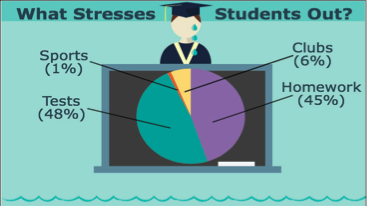Teenagers weigh obligations of today versus previous decades
Teenagers and adults alike have had stressful facets of their lives throughout history.
According to USA Today, 27 percent of teens experience “exam stress” during the school year, as compared to 13 percent in the summer.Thirty-four percent of surveyed teens say they expect to feel stress in their next year if schooling.
During the 1930s, such issues as the Great Depression and the Dust Bowl led to decreased education, malnutrition and a rising death rate for children.
Stressful situations for American teens have changed significantly within the last ten years, with much less physical and financial problems becoming prominent parts of teens’ lives.
Modern teenagers face problems more associated with schoolwork and extracurriculars, particularly towards the end of a semester when tests and exams become much more common.
“A day where all the teachers cram a ton of tests into one day before a big break. Th at is hashtag the struggle.” Joe Ryan, junior said.
As compared to the increased workload that modern students face on a daily basis, teenagers during the 1930s were faced with minimal opportunities to obtain educations.
According to “Life During the Great Depression”, published by academic.mu.edu, most schools between the period of 1932-1933 were shut down due to lack of funds, with the exception of those with teachers who cared little about monetary compensation.
Due to the common diffi culties in obtaining an education in the 30s many teenagers would resort to abandoning their homes and stowing away on trains in order to find jobs across the country. According to “Teenage Hoboes in the Great Depression” from the National Heritage Museum, over 250,000 children within the range of 16-25 years of age began riding the rails in search of employment.
“A stressful day for me involves multiple AP tests in a single day, with rehearsal after school, work,” Ashley Morales- Pacheo, s e n i o r , s a i d . “ Then volunteering, only to be followed by hours upon hours of homework, causing me to go to bed around 1 a.m.”
This overflow of volunteering and after-school jobs appears to be commonplace among teenagers, as they attempt to pay for their own expenses, or serve time in their community to meet school and scholarship requirements.
However, during the Great Depression, teens mostly spent their time working in order to feed themselves or their families.
“How Young Americans Survived the Hard Times of the Great Depression” by Errol Lincoln Uys details the lives of various young teens and their families who rode the rails in search of work for menial pay.
“Having three tests, two club meetings…I also had a copy to write for yearbook, so that’s a thing,” Luke Brittain, senior, said.
Aside from the modern stresses of teens, teachers also face the struggles of dealing with a modern age of meeting educational and societal needs.
“Club days. You wind up having to teach the kids faster and reteach it to them later on,” Richard Marchant, Pre-calculus and AP Calculus AB teacher, said.
Examining the lives of teenagers in the modern age presents an interesting contrast towards the lives of teens growing up in the 1930s, particularly in their


